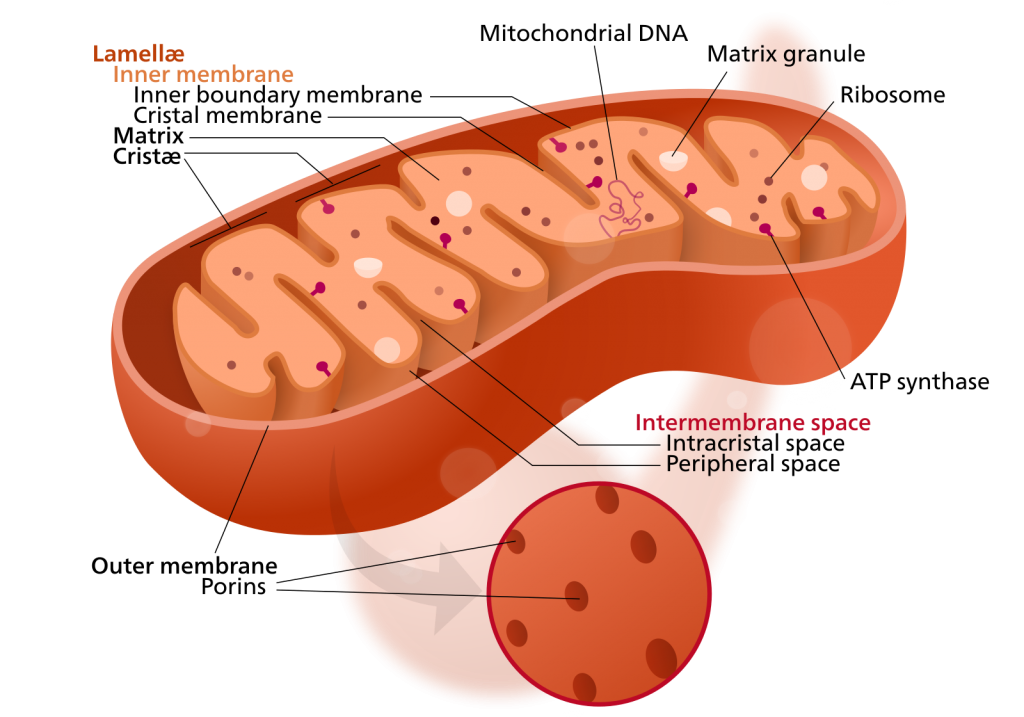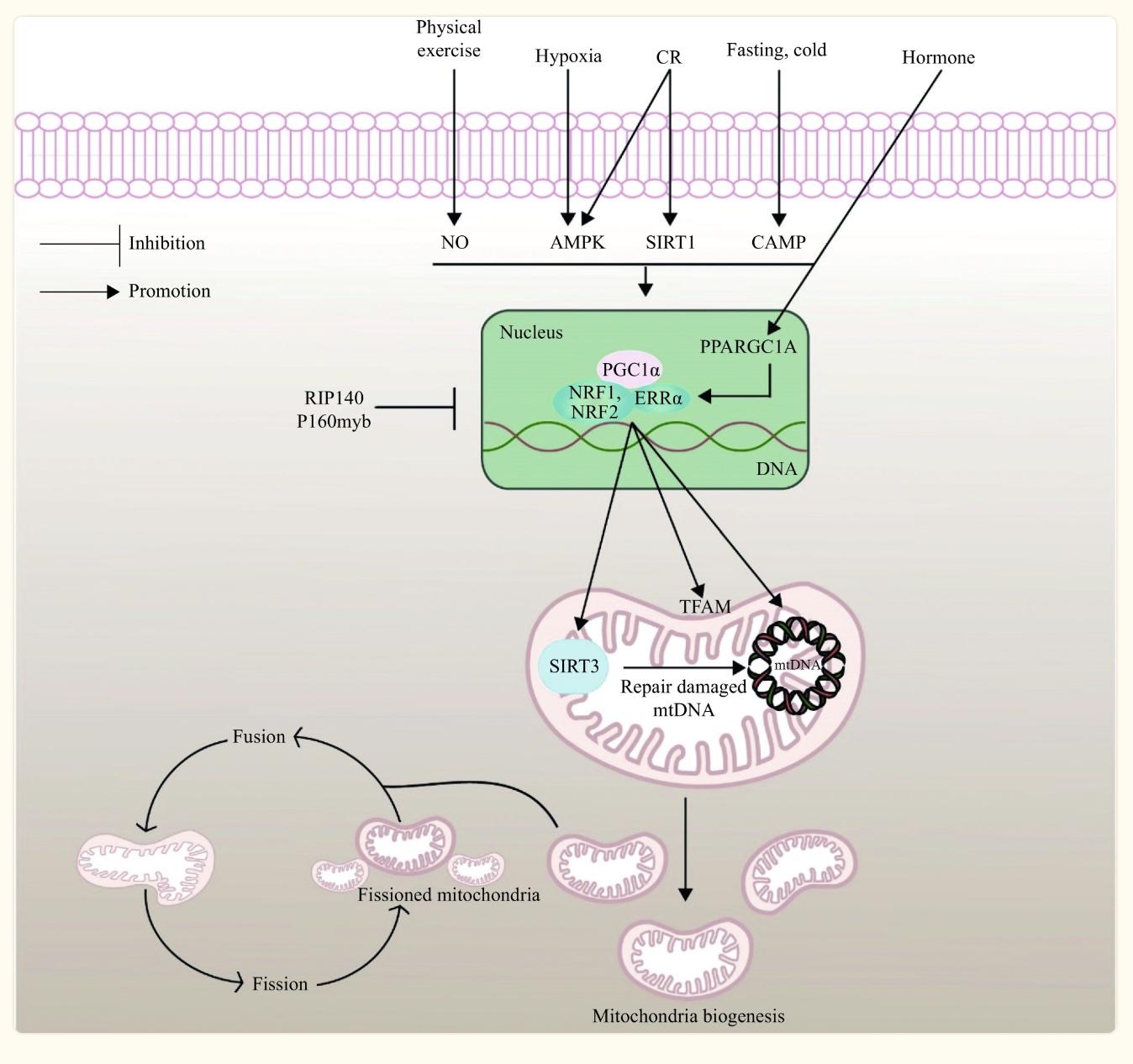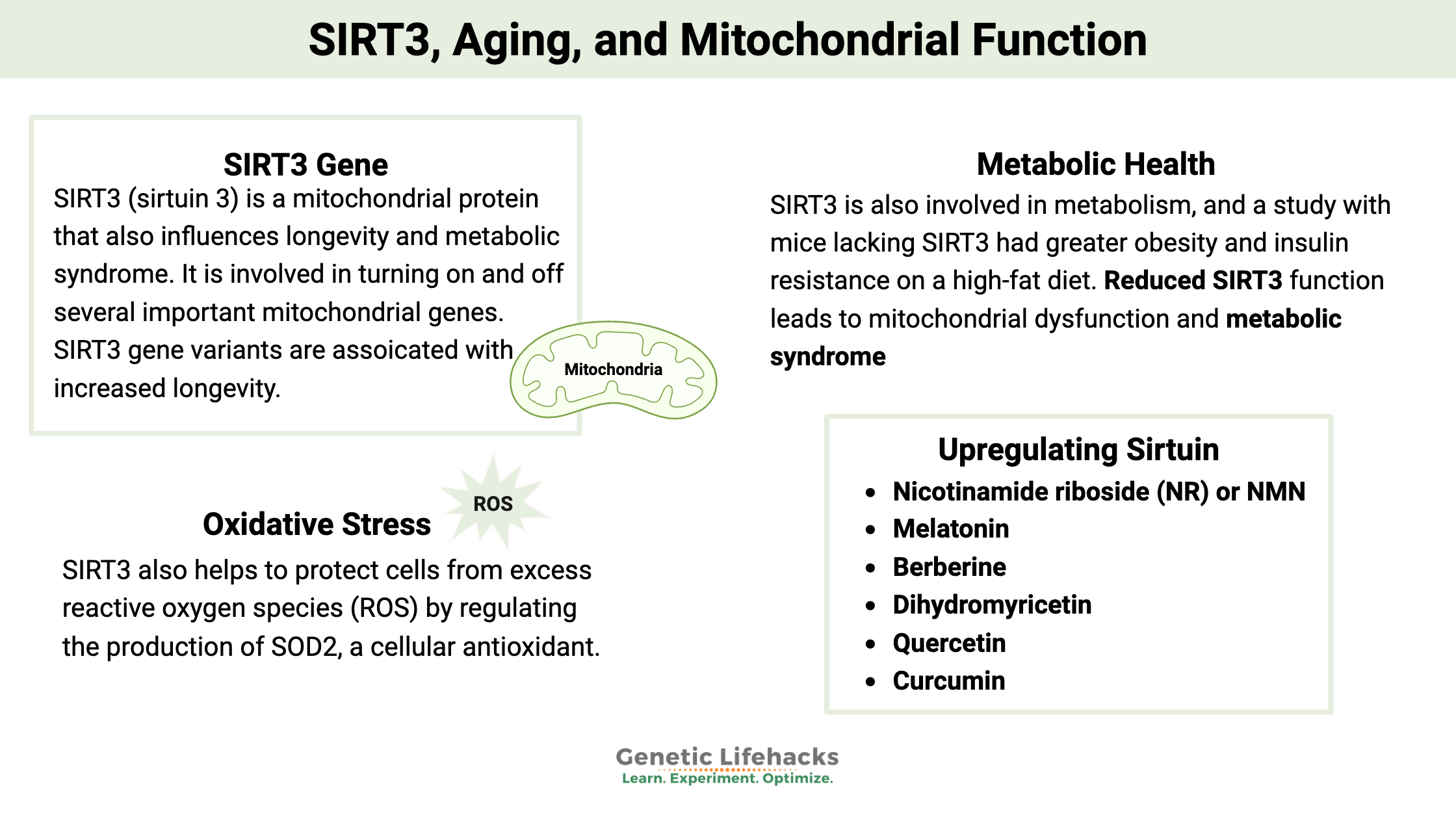Key takeaways:
~SIRT3 is part of the family of sirtuin genes that can regulate cellular functions.
~Essential for mitochondrial energy production, SIRT3 expression also helps to upregulate antioxidant genes. In addition, SIRT3 helps fight off certain infectious diseases.
~ Genetic variants in SIRT3 are linked to increased longevity, protection from tuberculosis, and metabolic health changes. [ref]
~ You can increase SIRT3 expression through cold exposure, natural supplements, or fasting.
Mitochondria, Energy (ATP), and Sirtuins:
Your mitochondria (the ‘powerhouse of the cell’) are vital to your health and longevity. In the mitochondria, molecules from the food that you eat are converted into energy and then stored as ATP (adenosine triphosphate).
When other parts of your cells need energy, a bond in the ATP molecule breaks and releases energy. Then the ATP can be recycled and regenerated to use again when energy is needed. I think of it kind of like a rechargeable battery.
Cells have anywhere from dozens to thousands of mitochondria in them, depending on the type of cell. (Egg cells can have hundreds of thousands of mitochondria per cell!)
Cells that need a lot of energy, like heart muscle cells and liver cells, have more mitochondria, while tiny red blood cells are the only cell type that doesn’t contain mitochondria.

The inner membrane of the mitochondria is where a lot of the magic happens. It is here that a series of reactions change the electrical potential (think energy) across the membrane. This is called the electron transport chain.
Related article: CoQ10 and Mitochondrial Energy
The source of chemical energy for the mitochondria is the food you eat – or your own stored fat. In addition, your cells need ways of moving the electrons across the membrane. This is done with molecules that accept and donate electrons.
NAD+ and FAD are the two key molecules here. We get FAD from riboflavin (vitamin B2) and NAD+ from niacinamide (vitamin B3, niacin).
Cells also need a way to turn on and off the production of the necessary proteins inside the mitochondria. Plus, cells need to take care of oxidative stress that results from mitochondrial energy production. This is where sirtuins come in — along with NAD+.
What do sirtuins have to do with aging?
Sirtuins are a family of seven proteins that are important in removing acetyl groups from molecules. This is called deacetylation.
In the cell nucleus, acetyl groups attach to the DNA at specific sites, marking and opening up the DNA for transcription. They are like a chemical post-it note, pointing to what needs to be transcribed and made into a protein.
Sirtuins remove the acetyl group at the right time, allowing the DNA to compact again and protect it from damage. The ability to turn genes on and off for transcription is what allows your body to function.
Acetylation isn’t just limited to histones and DNA. It can also be a way to modify or alter a protein after it has been synthesized. Deacetylation by SIRT3 can then reverse the acetylation, turning a protein back on for use in the cell.
Sirtuin activation occurs by NAD+ (nicotinamide adenine dinucleotide). Thus, NAD is also an essential component of mitochondrial energy production.
Related Article: NAD+, nicotinamide riboside, and NMN)
What does SIRT3 do?
SIRT3 (sirtuin 3) is a mitochondrial protein that also influences longevity and metabolic syndrome. It is involved in turning on and off several important mitochondrial genes through deacetylation.
Mitochondrial regulation:
SIRT3 regulates several mitochondrial proteins that are directly involved in mitochondrial ATP production, such as complexes I, II, and III.[ref]

Protects cells from oxidative stress:
SIRT3 also helps to protect cells from excess reactive oxygen species (ROS) by regulating the production of SOD2, a cellular antioxidant. Animal studies show that overexpression of SIRT3 increases the antioxidant capacity of cells.[ref]
Metabolic health:
SIRT3 is also involved in metabolism, and a study with mice lacking SIRT3 had greater obesity and insulin resistance on a high-fat diet. Reduced SIRT3 function leads to mitochondrial dysfunction and metabolic syndrome.[ref][ref]
Cancer prevention — and cancer promotion:
By promoting mitochondrial health and reducing ROS, SIRT3 can protect against cancerous mutations arising in the DNA.
Studies show that mice with the SIRT3 gene deleted are more likely to have tumors. In humans, breast cancer tissue shows deletion of SIRT3 in 40% of tumors.[ref]
While SIRT3 is important in preventing cancer, it can be a double-edged sword once cancer is present, depending on the type of cancer. SIRT3 inhibits the Warburg effect, but it also promotes cell metabolism and growth. So depending on how the tumor cells make energy, SIRT3 can be a positive or a negative.[ref]
Infectious diseases:
Recently, researchers discovered that SIRT3 is essential for promoting the cellular response to tuberculosis infection. Genetic variants in SIRT3 are linked to susceptibility to tuberculosis.[ref] Newcastle disease virus also interacts with SIRT3, degrading SIRT3 and impairing mitochondrial function.[ref] Hepatitis B replication is also reduced by SIRT3.[ref]
What activates SIRT3?
Environmental factors:
Researchers have found that both exposure to cold and calorie restriction upregulate SIRT3.[ref]
Studies show that calorie restriction slows age-related hearing loss by increasing SIRT3 “by promoting the glutathione-mediated mitochondrial antioxidant defense system.” [ref][ref]
NAD+ or nicotinamide riboside: A study in Cell Metabolism explained that nicotinamide riboside, a precursor of NAD+ and a derivative of vitamin B3, could prevent noise-induced hearing loss in mice. The researchers found that nicotinamide riboside activated SIRT3 in the mitochondria. This increase in SIRT3 prevented noise-induced hearing loss. Moreover, the addition of nicotinamide riboside (NR) was effective either before or after the hearing loss.[ref][ref]
Longevity and SIRT3:
Mitochondrial function is essential for healthy aging, and SIRT3 helps reduce mitochondrial oxidative stress. [ref]
Genetic variants (SNPs) in SIRT3 are associated with increased average lifespan, and increasing SIRT3 levels can extend lifespan in animals.[ref]
In a recent genome-wide association study, a SIRT3 variant that decreases SIRT3 expression was identified as significantly increasing the risk of intracranial aneurysm.[ref] This is likely to indirectly affect lifespan, with low SIRT3 increasing the risk of aneurysm.
SIRT3 may be involved in longevity through interaction with FOXO3, which “modulates mitochondrial mass, A/TP production, and clearance of defective mitochondria”.[ref] FOXO3 genetic variants are also associated with increased longevity.
SIRT3 Genotype Report:
Access this content:
An active subscription is required to access this content.
Lifehacks:
Please talk with your doctor or pharmacist if you have any questions about supplements, especially if you are taking prescription medications. Keep in mind that upregulating SIRT3 may not be a good idea in certain types of cancer.
How can I boost my sirtuins?
Here are 7 natural supplements with research showing that they boost SIRT3:
Access this content:
An active subscription is required to access this content.
Related Articles and Topics:
Serotonin 2A receptor: Psychedelic response and Alzheimer’s disease
References:
Airhart, Sophia E., et al. “An Open-Label, Non-Randomized Study of the Pharmacokinetics of the Nutritional Supplement Nicotinamide Riboside (NR) and Its Effects on Blood NAD+ Levels in Healthy Volunteers.” PloS One, vol. 12, no. 12, 2017, p. e0186459. PubMed, https://doi.org/10.1371/journal.pone.0186459.
Albani, Diego, et al. “Modulation of Human Longevity by SIRT3 Single Nucleotide Polymorphisms in the Prospective Study ‘Treviso Longeva (TRELONG).’” Age, vol. 36, no. 1, Feb. 2014, pp. 469–78. PubMed Central, https://doi.org/10.1007/s11357-013-9559-2.
Brown, Kevin D., et al. “Activation of SIRT3 by the NAD+ Precursor Nicotinamide Riboside Protects from Noise-Induced Hearing Loss.” Cell Metabolism, vol. 20, no. 6, Dec. 2014, pp. 1059–68. www.cell.com, https://doi.org/10.1016/j.cmet.2014.11.003.
Could a Vitamin Supplement Prevent Hearing Loss? 3 Dec. 2014, https://www.medicalnewstoday.com/articles/286408.
Han, Chul, and Shinichi Someya. “Maintaining Good Hearing: Calorie Restriction, Sirt3, and Glutathione.” Experimental Gerontology, vol. 48, no. 10, Oct. 2013, pp. 1091–95. PubMed Central, https://doi.org/10.1016/j.exger.2013.02.014.
Hirschey, Matthew D., et al. “SIRT3 Deficiency and Mitochondrial Protein Hyperacetylation Accelerate the Development of the Metabolic Syndrome.” Molecular Cell, vol. 44, no. 2, Oct. 2011, pp. 177–90. PubMed Central, https://doi.org/10.1016/j.molcel.2011.07.019.
—. “SIRT3 Deficiency and Mitochondrial Protein Hyperacetylation Accelerate the Development of the Metabolic Syndrome.” Molecular Cell, vol. 44, no. 2, Oct. 2011, pp. 177–90. PubMed Central, https://doi.org/10.1016/j.molcel.2011.07.019.
Kane, Alice E., and David A. Sinclair. “Sirtuins and NAD+ in the Development and Treatment of Metabolic and Cardiovascular Diseases.” Circulation Research, vol. 123, no. 7, Sept. 2018, p. 868. www.ncbi.nlm.nih.gov, https://doi.org/10.1161/CIRCRESAHA.118.312498.
—. “Sirtuins and NAD+ in the Development and Treatment of Metabolic and Cardiovascular Diseases.” Circulation Research, vol. 123, no. 7, Sept. 2018, pp. 868–85. PubMed, https://doi.org/10.1161/CIRCRESAHA.118.312498.
Lombard, David B., and Bernadette M. M. Zwaans. “SIRT3: As Simple as It Seems?” Gerontology, vol. 60, no. 1, 2014. www.ncbi.nlm.nih.gov, https://doi.org/10.1159/000354382.
Marcus, Joshua M., and Shaida A. Andrabi. “SIRT3 Regulation Under Cellular Stress: Making Sense of the Ups and Downs.” Frontiers in Neuroscience, vol. 12, Nov. 2018, p. 799. PubMed Central, https://doi.org/10.3389/fnins.2018.00799.
Reiter, Russel J., et al. “Melatonin Mitigates Mitochondrial Meltdown: Interactions with SIRT3.” International Journal of Molecular Sciences, vol. 19, no. 8, Aug. 2018, p. 2439. PubMed Central, https://doi.org/10.3390/ijms19082439.
Someya, Shinichi, et al. “Sirt3 Mediates Reduction of Oxidative Damage and Prevention of Age-Related Hearing Loss under Caloric Restriction.” Cell, vol. 143, no. 5, Nov. 2010, pp. 802–12. PubMed, https://doi.org/10.1016/j.cell.2010.10.002.
Tseng, Anne H. H., et al. “SIRT3 Deacetylates FOXO3 to Protect Mitochondria against Oxidative Damage.” Free Radical Biology & Medicine, vol. 63, Oct. 2013, pp. 222–34. PubMed, https://doi.org/10.1016/j.freeradbiomed.2013.05.002.
Yin, Xiaoyun, et al. “Genetic and Functional Sequence Variants of the SIRT3 Gene Promoter in Myocardial Infarction.” PLOS ONE, vol. 11, no. 4, Apr. 2016, p. e0153815. PLoS Journals, https://doi.org/10.1371/journal.pone.0153815.

